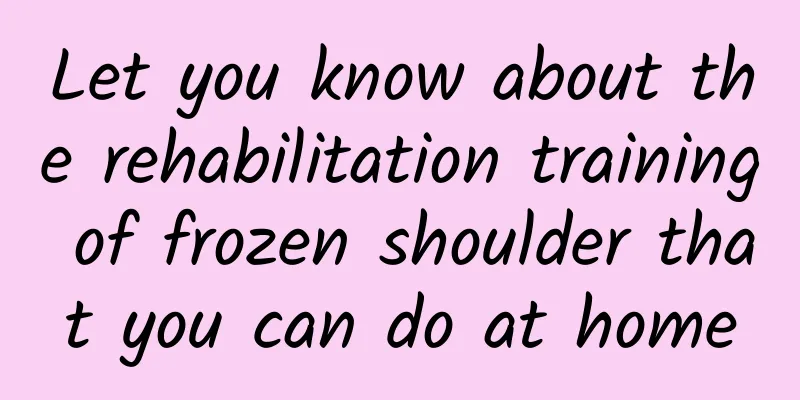Let you know about the rehabilitation training of frozen shoulder that you can do at home

|
Author: Tang Qin, Researcher of Chinese Medical Association Reviewer: Zhang Xin, deputy chief physician, Peking University Third Hospital The shoulder joint is vital to our daily life and work, so we must pay attention to diseases related to shoulder joint movement, especially frozen shoulder, which has a slow onset and persistent pain symptoms. Early detection and rehabilitation training can effectively improve the pain caused by frozen shoulder. 1. Periarthritis of shoulder and its main symptoms Scapulohumeral periarthritis, also known as periarthritis of the shoulder, is a chronic aseptic inflammation caused by soft tissue damage and degenerative lesions of the muscles, ligaments, tendons, etc. around the shoulder joint. It is commonly known as "frozen shoulder" or "frozen shoulder". It has extensive pathological characteristics, namely a wide range of pain, widespread functional limitation and a wide range of tenderness. Figure 1 Copyright image, no permission to reprint Frozen shoulder is a common shoulder disease in clinical practice, with a high incidence rate. Most patients are female, and most of them are middle-aged and elderly people. There are many reasons that can cause frozen shoulder, including age, excessive activity, bad posture, acute injury, too little shoulder activity or too long immobilization, and other shoulder factors, as well as cervical spondylosis, other organ diseases, psychological damage and other shoulder factors. Pain is one of the main symptoms of frozen shoulder. In the early stage of the disease, the shoulder will have intermittent pain, and then the pain will gradually intensify. It may be dull pain or "knife-like" pain, and it is continuous. When the climate changes or you are tired, the pain tends to worsen and spread to the surrounding area. Generally, the pain is more obvious at night than during the day, so the pain is lighter during the day and heavier at night is a major feature of frozen shoulder. Limited movement is another major symptom of frozen shoulder. No matter which direction the shoulder joint moves, it will be limited. For example, patients sometimes cannot do simple daily actions such as dressing and washing their faces. In severe cases, even the function of the elbow joint will be affected. In addition, if you have frozen shoulder, your shoulder joint will be particularly sensitive to cold, and when you press the tissues around the shoulder joint, you will feel obvious pain, and sometimes the muscles around the shoulder will spasm or atrophy. If the patient is older or has a long course of illness, X-ray examinations often show symptoms such as osteoporosis in the shoulder. 2. There are three main steps to do shoulder periarthritis rehabilitation training at home Rehabilitation training is very important for patients with periarthritis of the shoulder. Its main purpose is to stretch the shoulder joint through stretching exercises, so as to improve the adhesion of the tissues around the shoulder joint and relieve muscle spasms, thereby reducing or eliminating shoulder pain and facilitating the recovery of the normal range of motion and function of the shoulder joint. Most of the time, rehabilitation training for frozen shoulder can be performed at home, and there are mainly three steps. First, prepare before training . To help relax the spasmodic muscles, you can first apply heat to the shoulder joint with a hot towel. If the patient feels severe pain or is sensitive to pain, you can take nonsteroidal anti-inflammatory drugs 0.5 to 1 hour in advance. This can relieve pain during rehabilitation training and reduce swelling after rehabilitation training. The second is stretching training . Because the limitation of flexion (from front to top), abduction and external rotation (from outside to top) and extension (backward) are common symptoms of frozen shoulder, the rehabilitation training mainly stretches the shoulder joint in these directions, as follows. Wall climbing exercise : Stand facing, sideways or back against a wall with your feet shoulder-width apart. Use both hands to slowly climb up the wall. Stop when you can't climb anymore. Raise your upper limbs as high as possible within the pain range. When you reach the top, stay still for a while, then slowly return to the original position. Figure 2 Copyright image, no permission to reprint Pendulum exercise : Stand with your feet shoulder-width apart, lean forward, straighten your upper limbs and let them hang naturally, and swing in flexion and extension, adduction and abduction, or rotation. The range of motion increases from small to large, and the amount of activity increases from little to much. Supported stretching exercises : Stand facing forward, sideways or back on the edge of a table or chair, support yourself with both hands, straighten your elbows, squat down, use your body weight to stretch the affected limb forward and upward, until it hurts slightly, stay still for a while when you reach the maximum angle, then slowly stand up. "Combing hair" exercise : Use both hands alternately from the forehead, top of the head, behind the pillow, and behind the ears, and then circle the head forward and vertically, similar to the "combing hair" action. Figure 3 Copyright image, no permission to reprint In addition, you can also use some fitness equipment in the community or park to perform rehabilitation training for frozen shoulder. Common ones include upper limb traction device, Tai Chi massage and push device, and sit-and-pull trainer. Finally, ice compress after rehabilitation training . During rehabilitation training, the scar tissue around the shoulder joint is stretched to the maximum extent, which may cause tissue swelling and even a small amount of bleeding. Ice compress is needed to shrink capillaries and reduce the swelling and pain of the shoulder joint caused by tissue fluid exudation and bleeding. Ice compress should not exceed 30 minutes each time, and can be repeated as needed. 3. Precautions for rehabilitation training Moderate and correct training has a positive effect on the recovery of the shoulder joint. Excessive or incorrect training will affect the recovery of the shoulder joint. Therefore, the rehabilitation training of frozen shoulder must pay attention to the following points. First of all , you need to have a certain understanding of the range of motion of your shoulder joint before training. For example, when practicing wall climbing, you should mark it well. Each time you climb the wall, the height should exceed or be equal to the previous one. If it is lower each time, you must find out the reason yourself or go to the hospital for treatment. Both upper limbs should be trained together to prevent compensation of the healthy limb on the opposite side. For example, during abduction training, if only the affected limb is trained, the affected limb may be abducted to a higher height, but in fact it is caused by the lowering of the opposite shoulder to compensate. Secondly , try to train during the day to avoid pain affecting sleep. At the same time, you should also control the intensity and amplitude of the training, so that it is slightly painful and tolerable. The swelling and pain caused by training will generally disappear a few hours after training. If there are still symptoms the next day, it means you are overtraining. Finally , during training, you can take nonsteroidal anti-inflammatory drugs orally and use topical creams to enhance the analgesic and swelling-reducing effects to achieve better training results. Rehabilitation training for frozen shoulder is a slow recovery process. No matter which method is used, it should be carried out according to your specific situation. Don't rush it, otherwise it may backfire. References 【1】Gao Xiaoping. Family rehabilitation for neck and shoulder pain[M]. Beijing: Publishing House of Electronics Industry, 2021. |
<<: Embrace your vulnerable self: How to accept yourself
Recommend
Formation and treatment of uterine fibroids
Uterine fibroids are the most common malignant tu...
What is the reason for very little menstrual flow?
Menstruation is the menstrual cycle that women ha...
A good way to enlarge breasts before going to bed
The slender A4 waist and the enticing crotch make...
What are the steps to remove makeup?
Putting on and removing makeup can be said to be ...
What to do if flat warts grow on the breast
I don't know if you have heard of the virus c...
How many months of pregnancy can you abort the fetus
In the early stages of a woman's pregnancy, i...
Can you bring durian on the train? How to ripen the hard durian?
Durian is rich in nutrients and is known as the &...
Hundreds of millions of people are lactose intolerant, so why are we still recommending you to drink milk?
There is no need to say much about the benefits o...
Who needs regular eye examinations?
1. Diabetic patients Patients with diabetes who h...
Abnormal menstruation after abortion and its causes
Many women who have had an abortion have some con...
Eating snacks at this time is actually helpful for controlling blood sugar?
Whether they are relaxing or busy at work, many f...
Uncomfortable burning sensation below
In life, many women have some gynecological disea...
How to relieve primary dysmenorrhea?
There are many factors that cause dysmenorrhea. S...
What to do if there is excess fat on the vulva
The vulva belongs to the female lower body. In fa...
The efficacy of Jingdaining capsule
Menstruation is a condition of women's health...









